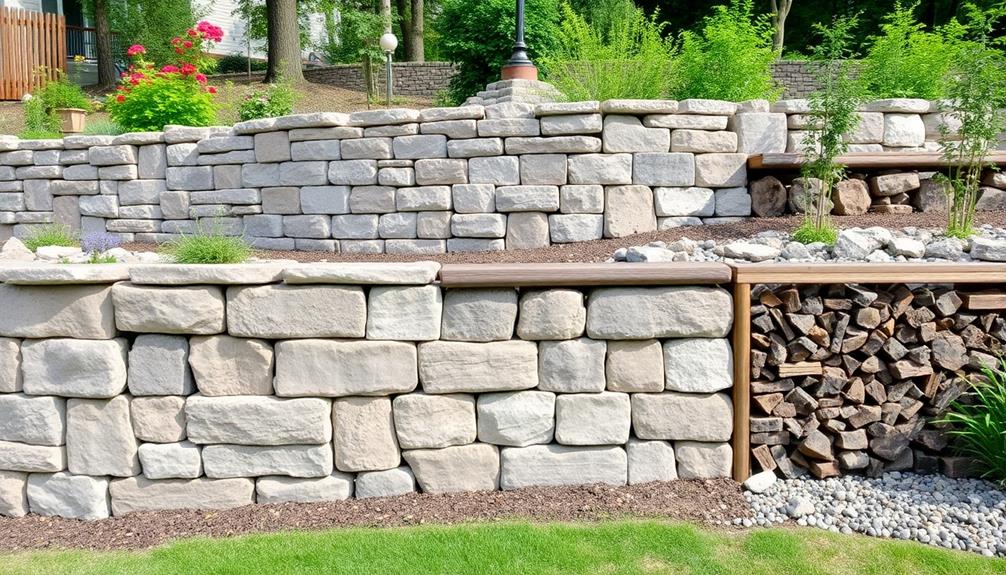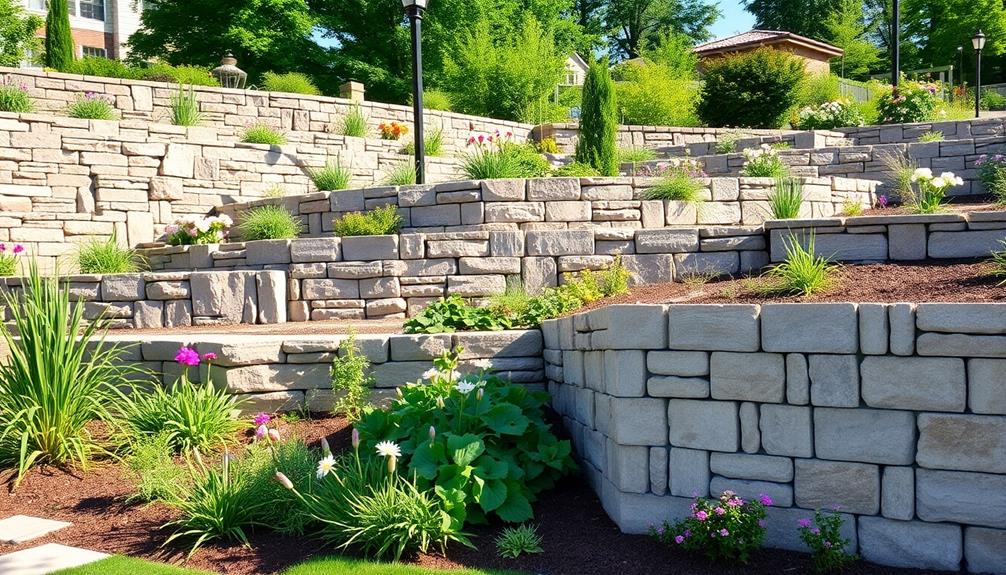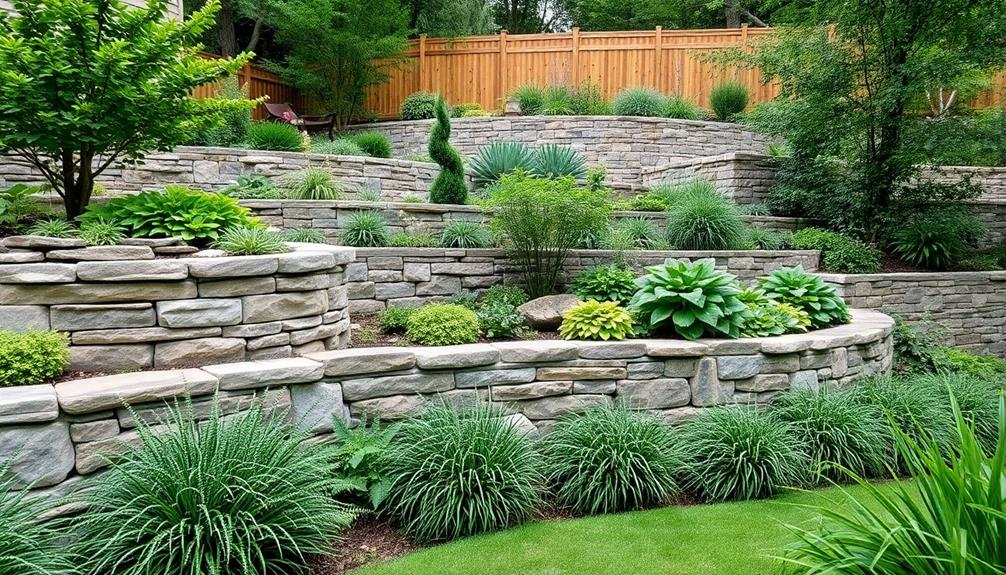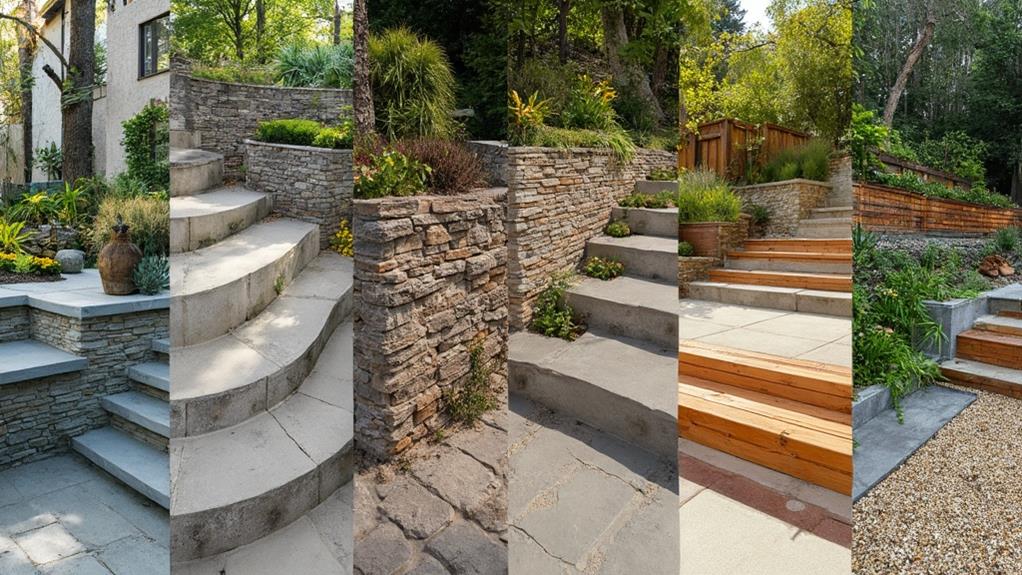In 2023, retaining wall materials are characterized by innovation and variety, serving both functional and aesthetic purposes. Concrete blocks stand out for their structural integrity and modern design potential, offering resilience and ease of installation. Natural stone, with its enduring beauty and high resistance to weather, is prized for enhancing property value. Wood timbers lend a rustic charm but require upkeep to maintain durability. Gabion walls present an eco-friendly alternative, offering impressive drainage and adaptability to natural landscapes. Each material offers unique advantages, facilitating environmentally conscious, cost-effective choices tailored to diverse architectural and geographical needs, promising an insightful exploration of possibilities.
Table of Contents
ToggleWalls Contractor Highlights
- Concrete blocks offer versatility, strong structural integrity, and ease of installation for modern retaining walls.
- Natural stone provides timeless beauty, high density, and excellent durability in various weather conditions.
- Wood timbers offer a rustic aesthetic and require regular maintenance for increased durability against rot and pests.
- Gabion walls integrate natural aesthetics with eco-friendly construction and effective drainage capabilities.
- Retaining wall materials with reduced emissions and reclaimed materials align with eco-friendly values and sustainability.
Definition of Retaining Walls

Retaining walls serve a fundamental purpose by providing structural support to prevent soil erosion and manage changes in land elevation, making them indispensable for both practical and aesthetic landscaping solutions. These walls are carefully designed and constructed to withstand lateral pressure from the retained material, and their functionality is largely influenced by the choice of materials, which range from traditional stone and timber to modern concrete and steel.
Some options, such as boulder walls, enhance visual appeal and offer a sustainable, eco-friendly solution for landscaping and erosion control. Understanding the diverse types of materials available is pivotal for ensuring the durability, cost-effectiveness, and environmental compatibility of retaining walls in various applications.
Purpose and Functionality
Acting as steadfast barriers against gravity, retaining walls serve a fundamental role in landscape architecture and civil engineering. These structures are meticulously designed to resist lateral pressure due to soil load, thereby preventing erosion and managing ground instability. They enable the transformation of previously unusable terrains into functional and aesthetically pleasing areas, facilitating the harmonious integration of manmade construction with natural environment.
The purpose of retaining walls extends beyond mere support. They play a critical role in water management by directing rainwater runoff, thereby protecting adjacent infrastructure from water damage. Additionally, they assure soil retention on steep grades, which is essential in both residential projects and large-scale developments. This makes them indispensable in creating level platforms for buildings, roadways, and pathways, consequently enabling a blend of practicality with visual appeal.
Functionally, retaining walls are crucial in stabilizing sloped landscapes, mitigating landslide risks, and optimizing space usage. They allow communities to reclaim land that would otherwise be unsafe or unusable, enhancing property value and improving aesthetics. By transforming challenging topography into habitable land, retaining walls contribute considerably to the creation of sustainable and inclusive ecosystems.
Design and Structure
In considering the multifaceted roles that retaining walls play, it's important to examine their underlying design and structure, which are equally critical to their effectiveness. Retaining walls serve not only as essential landscape elements that hold back soil but also as architectural features that enhance aesthetic appeal.
The design of these walls involves careful planning, taking into account the height of the wall, the load it must support, and the angle of the retained soil. Engineers employ principles of civil engineering to determine the best structural approach, ensuring stability and long-term integrity.
The structural integrity of a retaining wall depends on a delicate balance of pressure exerted by the retained earth, the drainage of water to prevent hydrostatic pressure buildup, and the material's inherent strength. Achieving such equilibrium involves the strategic use of anchors, footings, and reinforcements to withstand the natural forces at play.
Gravity, cantilever, and anchored walls are among the common designs, each with unique attributes tailored for specific site requirements. Ultimately, a well-constructed retaining wall seamlessly integrates into its environment, embodying the technical prowess and aesthetic sensibilities that its community values and relies upon for sustainable landscape architecture.
Types of Materials
Material selection is a pivotal factor in the construction of retaining walls, influencing both functionality and visual appeal. Retaining walls serve as essential components, preventing soil erosion and managing land on inclined terrain, while simultaneously enhancing landscape aesthetics. The choice of material is integral to ensuring a wall's strength, durability, and maintenance requirements, capturing a shared sense of cohesiveness within community and private landscapes.
Key materials dominating the retaining wall industry in 2023 include:
- Concrete Blocks: Known for their robust structural integrity and ease of installation, concrete blocks provide versatility and modern design options, seamlessly aligning function and form within landscapes.
- Natural Stone: Evoking timeless beauty, natural stone systems enhance property value through their organic appeal and alignment with nature, while offering long-lasting performance in various weather conditions.
- Wood Timbers: Popular for rustic and naturalistic environments, wood timbers deliver an earthy connection to surrounding elements yet demand regular maintenance to combat potential decay and insects.
- Gabion Walls: Constructed from wire mesh filled with stone or similar materials, gabion walls present a unique and eco-conscious option, effectively integrating into landscapes with natural aesthetics and providing substantial drainage capabilities.
Benefits

Retaining wall materials in 2023 offer numerous benefits, combining strength and durability with an aesthetically versatile array of options that cater to both residential and commercial landscapes. These materials not only enhance visual appeal but also incorporate eco-friendly advantages, supporting sustainable construction practices.
Strength and Durability
When selecting materials for retaining walls, strength and durability stand out as primary benefits, essential for long-lasting stability and performance. These attributes are critical for withstanding environmental pressures and preserving the structure's integrity over time. Strength and durability in retaining walls foster a sense of security and belonging, as individuals are reassured by a structure that stands resilient in the face of time and weather.
Concrete Blocks: Renowned for their robustness, concrete blocks offer significant compressive strength, making them a reliable choice for enduring heavy loads and sustaining structural cohesion. They resist erosion effectively, ensuring longevity.
Natural Stone: Celebrated for its innate durability, natural stone combats the elements with ease. Its high density provides a formidable barrier against water penetration, reducing wear and tear over decades.
Gabion Walls: Comprising wire cages filled with rugged stones, gabion walls excel in strength and flexibility. This combination allows them to absorb stress and shifts in the earth, thereby maintaining their form and function.
Wood Timbers: While not the strongest option, treated wood timbers offer reasonable durability for lighter structural needs. They are resistant to rot and pests thanks to specialized treatments, thereby extending their lifespan.
These materials collectively provide a strong foundation for constructing retaining walls that stand the test of time.
Aesthetic Versatility Options
In the domain of retaining wall construction, aesthetic versatility emerges as a significant benefit, allowing designers and homeowners to tailor structures that complement their surroundings. Modern retaining wall materials offer an impressive palette of options, guaranteeing each project can reflect the personal style and contextual harmony sought by those undertaking such endeavors.
The integration of various textures, colors, and finishes enables a seamless alignment with the aesthetic aspirations of any landscape setting. For instance, materials such as natural stone, brick, or timber confer a timeless appeal, evoking a sense of tradition and continuity.
Enhanced by recent advancements in manufacturing, contemporary options like concrete blocks offer versatility in shape and form, allowing for intricate designs previously unachievable with more rudimentary materials. Such flexibility not only honors architectural vision but also catalyzes a harmonious blend with existing landscape elements, fostering an inclusive environment where every garden, yard, or public space feels thoughtfully connected.
Paying attention to details such as color matching and style consistency guarantees that retaining walls can act as elegant extensions of the surrounding environment. This attention to detail resonates with a keen sense of belonging, where every structure is tailored to its context, marrying form and function.
Eco-Friendly Advantages
Amid growing environmental consciousness, the eco-friendly advantages of modern retaining wall materials are increasingly significant. As we endeavor for sustainable living, selecting materials that balance structural integrity with environmental stewardship becomes paramount. These innovations not only align with ecological values but also convey a broader commitment to a shared planet. Modern materials are crafted using sustainable resources and practices that minimize impact on the earth.
Reduced Carbon Footprint: Many of these materials, such as recycled concrete and mixed plastics, are produced with reduced emissions, supporting the global quest to lower carbon levels.
Natural Habitat Preservation: By selecting materials less intrusive to ecosystems, such as terraced gardens with local flora, we contribute to biodiversity protection while controlling soil erosion.
Waste Minimization: Utilization of reclaimed materials like wood and stone decreases landfill waste, embodying the principles of reuse and recycle.
Energy Efficiency in Production: The manufacturing processes often require less energy compared to traditional resources, thus conserving valuable natural energy reserves.
Embracing these options not only strengthens communities environmentally but also creates a sense of belonging to a conscientious and forward-thinking society.
Cost-Effective Choices
As budget constraints increasingly influence construction decisions, it becomes essential to identify retaining wall materials that offer both affordability and durability. Cost-effectiveness in this context highlights the need for materials that provide a long-term return on investment while maintaining structural integrity. Concrete blocks stand as a popular choice, providing not only economic efficiency but also resilience against weathering and time. These blocks are easy to install and require minimal maintenance, reducing overall costs over their lifespan.
For those seeking an eco-frugal approach, timber is a commendable option. While it offers an organic aesthetic that resonates with many landscaping designs, its preliminary cost is often lower compared to other materials. Nonetheless, considerations should be given to its treatment for longevity, which can slightly alter the initial cost assessment.
Moreover, reinforced earth solutions offer a modern twist on cost-effectiveness, utilizing geosynthetic materials to bolster traditional soil or rock walls. This approach blends low material costs with advanced engineering principles, ensuring stability and longevity.
Ultimately, choosing the ideal cost-effective solution aligns with understanding specific site needs and desired outcomes, fostering a sense of belonging as communities and creators collaboratively shape sustainable and enduring built environments.
Common Material Cost Factors

In evaluating the cost factors of retaining wall materials in 2023, one must consider the myriad influences such as material sourcing locations, which can dramatically affect transportation expenses and availability. Additionally, installation labor expenses often vary extensively depending on the complexity of the design and local wage standards, while environmental impact considerations increasingly dictate the use of sustainable or recycled materials, potentially leading to shifts in overall costs. The following table presents an organized view of these cost factors:
| Cost Factor | Description |
|---|---|
| Material Sourcing Locations | Distance and availability affecting transport costs |
| Installation Labor Expenses | Wage and time factors influenced by project complexity |
| Environmental Impact | Preference for eco-friendly materials altering cost dynamics |
| Local Wage Standards | Variation in labor costs due to geographic and economic conditions |
| Sustainable Material Premium | Additional costs associated with eco-conscious material choices |
Material Sourcing Locations
When choosing materials for retaining walls, material sourcing locations considerably impact costs, affecting the overall budget and feasibility of a project. The geographical origins of retaining wall materials can influence transportation expenses, availability, and even the project's timeline. Selecting relevant sourcing locations is essential, as a misstep can lead to unexpected financial constraints or compromises in material quality.
To navigate these considerations effectively, keep in mind the following:
- Proximity to Project Site: Procuring materials from nearby sources reduces transportation costs and delivery times, facilitating a more efficient construction process. This approach nurtures connections with local suppliers, fostering a sense of community and support.
- Material Availability: Local sourcing may aid in availability but, if specific materials are required that are scarce locally, costs may escalate. Comprehensive market research can identify suitable suppliers to balance cost and quality.
- Environmental Impact: Sourcing environmentally-friendly materials from sustainable locations minimizes ecological footprints and aligns with contemporary construction best practices, enhancing longevity and community trust.
- Regulatory Compliance: Certain areas impose regulations on the materials and sourcing practices. Ensuring compliance with these regulations prevents legal challenges and reinforces credibility within the community.
Analyzing these factors positions project stakeholders to make informed decisions, ultimately steering the project towards success.
Installation Labor Expenses
Although often overlooked, installation labor expenses substantially contribute to the overall cost of retaining wall projects. The complexity and scale of the installation process demand stringent precision and skilled craftsmanship, encompassing everything from site preparation to the final placements of materials. Skilled labor is essential for ensuring structural integrity and longevity, making it a significant financial consideration.
Consequently, geographic location, availability of skilled workers, and local wage rates can markedly influence the labor expenses associated with such construction endeavors. In regions where construction experts are in high demand, the cost for labor may rise accordingly, not only due to the supply and demand of skilled technicians but also as a result of regulatory factors, such as local building codes requiring certain certifications and expertise.
Nonetheless, the nature of the material involved—be it natural stone, concrete blocks, or timber—also plays a pivotal role in the overall labor expenses. Each material requires distinct handling techniques, tools, and equipment, creating a disparity in labor intensity and subsequent cost.
For those who meticulously plan their projects, taking into account these installation labor expenses not only fosters budgetary alignment but affirms a cohesive approach to realizing a robust, aesthetically appealing, and enduring retaining wall.
Environmental Impact Considerations
Considering the various expenses associated with retaining wall construction, environmental impact is an increasingly significant factor in determining common material costs. Clients are more attuned to sustainability, seeking choices that align not only with budget considerations but also with ecological footprints.
The environmental impact of different retaining wall materials calls for a thoughtful balance, as it influences both initial and long-term costs while reflecting our collective responsibility to future generations.
Key environmental impact metrics include:
- Carbon Footprint: The production processes for materials such as concrete and stone can greatly vary in emissions. Opting for materials produced with minimal energy can reduce overall carbon footprints.
- Sustainability of Source: Materials sourced from sustainable practices, including recycled content, offer less strain on natural resources, thereby lowering environmental costs.
- Durability and Longevity: Choosing materials with long lifespans translates to reduced frequency of replacement and maintenance needs, lessening the environmental burden over time.
- Integration with Local Ecosystem: Materials should blend harmoniously with local flora and fauna, avoiding disruptions in existing ecosystems which can create indirect costs.
For those committed to sustainable practices, these considerations not only assure cost-effectiveness but foster a sense of belonging in a responsible global community.
Walls Contractor FAQ
What Are the Environmental Impacts of Retaining Wall Materials?
The environmental impacts of retaining wall materials include considerations of resource extraction, longevity, and the carbon footprint of production processes. Sustainable choices foster community harmony by aligning construction practices with ecological stewardship, contributing to environmental balance and resilience.
How Do I Calculate the Height of a Retaining Wall?
To calculate a retaining wall's height, assess soil type, slope stability, and load conditions. Engage with local building codes and professionals to guarantee accurate measurements and compliance. Ultimately, community collaboration guarantees safe, effective, and aesthetically pleasing structures.
What Are the Maintenance Requirements for Different Retaining Wall Materials?
Maintenance requirements vary by material: timber walls need regular sealing to prevent rot; concrete demands crack checks and sealing; stone walls require weed management; and brick should have regular mortar inspections, maintaining integrity in every community's landscape.
How Long Does It Take to Construct a Retaining Wall?
The construction time for a retaining wall varies based on material choice, wall size, and site conditions, generally ranging from a few days to several weeks. Professional planning guarantees efficient completion, fostering a sense of project camaraderie and belonging.
What Are the Fire Resistance Properties of Retaining Wall Materials?
Fire resistance in retaining wall materials varies remarkably. Concrete and masonry offer high fire resistance, protecting structures effectively. Timber walls, however, are less fire-resistant, necessitating treatment for improved safety. Metal options provide moderate resistance, balancing affordability with protection.







